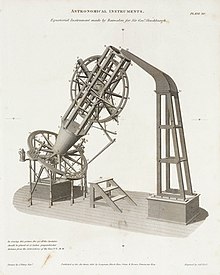NGC 5363
NGC 5363| NGC 5363 | |
|---|---|
 NGC 5363 by SDSS | |
| 관측 데이터(J2000 epoch) | |
| 별자리 | 처녀자리 |
| 우측 상승 | 13h 56m 07.2s[1] |
| 탈위임 | +05° 15′ 17″[1] |
| 레드시프트 | 0.003799 ± 0.000017 [1] |
| 헬리오 방사 속도 | 1,210 ± 5km/s[1] |
| 거리 | 63.6 ± 13 Mly(19.5 ± 4.1 Mpc)[1] |
| 겉보기 크기 (V) | 10.5 [2] |
| 특성. | |
| 유형 | I0?[1]/S0[3] |
| 겉보기 크기 (V) | 4′.1 × 2′.6 [1] |
| 주목할 만한 특징 | 라이너, 나선형 더스트 디스크 |
| 기타 지정 | |
| UGC 8847, CGCG 046-007, MCG +01-36-002, PGC 49547[1] | |
NGC 5363은 처녀자리(Virgo)에 위치한 렌즈 은하다.그것은 지구로부터 약 6천 5백만 광년 거리에 위치해 있는데, 이것은 명백한 치수로 볼 때 NGC 5363이 지름이 약 10만 광년이라는 것을 의미한다.그것은 1784년 1월 19일 윌리엄 허셜에 의해 발견되었다.[4]
특성.
NGC 5363은 중간 적외선 지도에서도 [5]볼 수 있고 중간 방향의 더 확장된 차선으로 특징지어진다.[6]은하의 총 한랭질량은 2×10M로6☉ 추정되며, 원적외선에서는 52 아크초간 연장된다.[7]먼지 방출은 나선팔과 막대 같은 구조를 가진 원반으로 나타나며 은하의 주요 축을 따라 희미하고 팔 같은 구조로 은하 바깥 부분에 확장된다.[8]이 은하는 나선형 원반을 형성하는 HII 방출도 특징으로 한다.[9]
총 먼지 질량은 진화된 별에 의해 손실된 질량에 의해서만 생성되었다면 예측한 것보다 약 100의 인자이다.[6]은하계에도 최근 합병의 증거인 조개껍데기가 있어 NGC 5363이 또 다른 은하에 붙었고, 따라서 성간 먼지는 외부로부터 발생한다는 주장이 강하게 제기된다.[9]젊은 별과 관련된 자외선이 검출된 것에서 알 수 있듯, 이번 합병 사건으로 은하계에서 별 형성 활동이 일어났을 가능성이 높다.[9]
그 스펙트럼에 근거해 NGC 5363의 핵이 활성인 것으로 밝혀져 라이너로 분류되었다.[10]NGC 5363의 중심에는 약 3억7500만 개의 질량을 가진 초질량 블랙홀이 놓여 있다.[11] NGC 5363은 전파를 방출하는 것으로 밝혀졌다.무선 소스는 직경이 2아크초 미만인 콤팩트 코어(compact core)와 아마도 확장된 구성 요소로 구성되어 있으며, 약 20아크초 동안 확장된다.[12]
인근 은하
NGC 5363 은하는 NGC 5363 그룹으로 알려진 은하군 중 가장 앞선 은하군이다.그룹의 다른 멤버로는 NGC 5300, NGC 5348, NGC 5356, NGC 5360, NGC 5364가 있다.[13]NGC 5363과 NGC 5364는 비접촉 쌍을 형성하며 14.5 아크 분간의 예상 거리에 놓여 있다.[14]이 그룹은 처녀자리 III 그룹의 일부로서, 처녀자리 은하단 왼쪽에 있는 매우 분명한 은하군 체인으로 4000만 광년 우주에 걸쳐 뻗어 있다.[15]
참고 항목
참조
- ^ a b c d e f g h "NASA/IPAC Extragalactic Database". Results for NGC 5363. Retrieved 2016-01-18.
- ^ "Revised NGC Data for NGC 5363". spider.seds.org. Retrieved 25 November 2018.
- ^ Ho, L. C.; Filippenko, A. V.; Sargent, W. L. (June 1995). "A search for 'dwarf' Seyfert nuclei. 2: an optical spectral atlas of the nuclei of nearby galaxies". The Astrophysical Journal Supplement Series. 98: 477. Bibcode:1995ApJS...98..477H. doi:10.1086/192170.
- ^ Seligman, Courtney. "NGC 5363 (= PGC 49547)". Celestial Atlas. Retrieved 19 November 2018.
- ^ Xilouris, E. M.; Madden, S. C.; Galliano, F.; Vigroux, L.; Sauvage, M. (26 February 2004). "Dust emission in early-type galaxies: The mid-infrared view". Astronomy & Astrophysics. 416 (1): 41–55. arXiv:astro-ph/0312029. Bibcode:2004A&A...416...41X. doi:10.1051/0004-6361:20034020. S2CID 12635736.
- ^ a b Patil, M. K.; Pandey, S. K.; Sahu, D. K.; Kembhavi, A. (26 September 2006). "Properties of dust in early-type galaxies". Astronomy & Astrophysics. 461 (1): 103–113. arXiv:astro-ph/0611369. doi:10.1051/0004-6361:20053512.
- ^ Temi, Pasquale; Brighenti, Fabrizio; Mathews, William G.; Bregman, Jesse D. (April 2004). "Cold Dust in Early-Type Galaxies. I. Observations". The Astrophysical Journal Supplement Series. 151 (2): 237–269. arXiv:astro-ph/0312248. Bibcode:2004ApJS..151..237T. doi:10.1086/381963. S2CID 118856747.
- ^ Pahre, Michael A.; Ashby, M. L. N.; Fazio, G. G.; Willner, S. P. (September 2004). "Spatial Distribution of Warm Dust in Early-Type Galaxies". The Astrophysical Journal Supplement Series. 154 (1): 229–234. arXiv:astro-ph/0406379. Bibcode:2004ApJS..154..229P. doi:10.1086/423320. S2CID 8841216.
- ^ a b c Finkelman, Ido; Brosch, Noah; Funes, José G.; Kniazev, Alexei Y.; Väisänen, Petri (22 July 2010). "Ionized gas in E/S0 galaxies with dust lanes". Monthly Notices of the Royal Astronomical Society. 407 (4): 2475–2500. arXiv:1005.4227. Bibcode:2010MNRAS.407.2475F. doi:10.1111/j.1365-2966.2010.17070.x. S2CID 117552408.
- ^ Ho, Luis C.; Filippenko, Alexei V.; Sargent, Wallace L. W. (October 1997). "A Search for "Dwarf Seyfert Nuclei. III. Spectroscopic Parameters and Properties of the Host Galaxies". The Astrophysical Journal Supplement Series. 112 (2): 315–390. arXiv:astro-ph/9704107. Bibcode:1997ApJS..112..315H. doi:10.1086/313041. S2CID 17086638.
- ^ Saikia, Payaswini; Körding, Elmar; Falcke, Heino (July 2015). "The Fundamental Plane of black hole activity in the optical band". Monthly Notices of the Royal Astronomical Society. 450 (3): 2317–2326. arXiv:1504.00363. Bibcode:2015MNRAS.450.2317S. doi:10.1093/mnras/stv731. S2CID 118515692.
- ^ Tovmasian, G. M.; Sramek, R. A. (November 1976). "The radio emission of NGC 5363". Astrofizika. 12: 693–696. Bibcode:1976Afz....12..693T.
- ^ Makarov, Dmitry; Karachentsev, Igor (21 April 2011). "Galaxy groups and clouds in the local (z∼ 0.01) Universe". Monthly Notices of the Royal Astronomical Society. 412 (4): 2498–2520. arXiv:1011.6277. Bibcode:2011MNRAS.412.2498M. doi:10.1111/j.1365-2966.2010.18071.x. S2CID 119194025.
- ^ de Vaucouleurs, G.; de Vaucouleurs, A.; Corwin, J. R. (1976). "Second reference catalogue of bright galaxies". Second Reference Catalogue of Bright Galaxies. 1976. Bibcode:1976RC2...C......0D.
- ^ "The Virgo III Groups". www.atlasoftheuniverse.com. Retrieved 9 January 2019.
외부 링크

